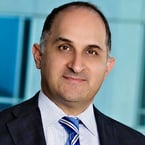A Volatile but Solid Start for 2016
What a year this has been, and it is only half over. The sentiment is that the first six months of the year produced events that have reshaped the economy, yet when we look at the markets – especially here in the U.S. – the data suggests not much has changed. Despite that, it was not the straightest of paths to arrive where we are today.
The first six weeks of 2016 saw global stock markets plunge, as investors worried that slowing growth in China could ripple worldwide and even tip the U.S. into recession. As those concerns eased and the Federal Reserve held back on raising interest rates, global markets reversed and staged a furious rally until the last week of June, when they were hit again. This time the global impact did not emanate from Asia, but from the United Kingdom’s vote to withdraw from the European Union, the so-called “Brexit.”
In the wake of the vote, the British prime minister resigned. Overnight, the British pound sterling fell 11% to 1.33 against the U.S. dollar – its lowest level since 1985. The Euro fell 2.4% to 1.10 versus the dollar. Global equity markets plummeted. The S&P 500 fell 3.6%, while the FTSE 100 dropped 8.7%. Away from equities, investors fled to “safe haven” investments: gold, Treasury bonds, and certain currencies, such as the Swiss Franc, Japanese Yen, and U.S. dollar. Days later, ratings agency Standard & Poor’s stripped the United Kingdom of its triple-A credit rating and downgraded the European Union’s ratings. Fitch and Moody’s, the other major ratings agencies, also cut their U.K. ratings.
All of this activity started to indicate things in 2016 were going to be different. However, in the week following the historic vote, global equities rallied as the quarter ended. This occurred in spite of significant uncertainty regarding the economic, political, and financial market implications of Brexit. When the dust settled, the S&P 500 ended the quarter up 3.84%. International equities, however, did not fare so well. The MSCI EAFE, an index designed to measure the equity market performance of developed markets outside of the U.S. and Canada, is down for the year. S&P 500 up, international equities down – a trend we have seen for several quarters now. Indeed, not much has changed.
Shelter from the Brexit Storm
Brexit’s reverberations across financial markets have been felt worldwide. So the question is: What are the investing implications of Brexit? As we see it, here are the key takeaways:
- The United Kingdom’s vote to leave the European Union may signal a shift away from globalization, which could lead to slower economic growth and higher inflation.
- Slow growth could be a headwind for corporate profits.
- A positive outcome of Brexit, for U.S. investors, is the possibility that the Federal Reserve may temper its plans to raise interest rates.
- Volatility may create key long-term buying opportunities.
Again, nothing has changed overnight in terms of company balance sheets, laws, or consumer consumption globally, but this has been a major shock to confidence levels and creates uncertainty about the future. It will take time for the markets and policymakers to make sense of Brexit and price securities accurately. The only known right now may be that the uncertainty surrounding Brexit is likely to endure. In the meantime, we will continue to invest as long-term value investors, focusing on those instruments that offer the best possible opportunities for our clients over their investment horizons. We continue to evaluate the ever-changing investment landscape. It is disruptions like these that often create key long-term buying opportunities.
Interest Rates
The biggest surprise this year has been the continued decline in interest rates. With all the noise related to anticipated interest rate hikes, it seemed as if everything was going to be different in 2016, yet nothing changed as the decline in rates continued. The yield on the 10-year Treasury bond closed the quarter at multi-year lows of under 1.5%, compared with 2.3% at year-end 2015. Interest rates around the world have fallen to record lows after Brexit. The S&P Global Developed Sovereign Bond Index hit a new record low of 0.4% as of June 30, 2016. Despite that, it has generated an 11% return so far this year in U.S.-dollar terms. Also, the amount of global debt with negative yields reached $11 trillion by the end of June, accounting for roughly 55% of total outstanding government debt in developed countries. Low current bond yields imply very low five-year expected returns for core bonds. However, as we have seen over the past several years, low yields don’t preclude strong returns over shorter-term periods if bond prices are driven higher by investor fears, ongoing Central Bank bond purchases, and/or speculative short-term macro bets. Eventually, though, the “bond math” catches up to you. In other words, you can’t escape the gravitational pull of the starting bond yield in determining your total return as a bond investor.
Fixed Income
One area where we did see a change was in fixed income, and it was a positive change. Our credit strategies reversed their negative trend from 2015 and began to produce positive results. We experienced strong performance in our credit strategies, with most of them beating the core bond index for both the quarter and year-to-date periods, while floating-rate loans slightly trailed core bonds.
While we continue to favor credit strategies and floating-rate loans over core bonds in our fixed income portfolios, core bonds remain an important risk reducer, as underscored by recent events. In fact, in the first quarter we increased our exposure to core bonds in most of our portfolios. We made the change based on our revised return assumptions and because the near-term risk of interest rates moving sharply higher now appears to be remote. Low rates in a non-recession scenario should mean upside in credit. Our fixed income strategy is to reduce interest rate risk while taking on some credit risk – in order to achieve higher yields – and patiently waiting for opportunities.
Equities
We have enjoyed good returns in equities and most of our strategies in 2016, but as we head into the second half of the year, we know it is not time to relax. As a result of the rise in value of many of our investments, we have been repositioning our portfolios by taking some profits in U.S. equities and REITs and becoming slightly more defensive. We are following the discipline of buying assets that we believe are cheap and selling assets when they are expensive. This is key to reducing risk. Our equity strategy is to emphasize U.S. Large Cap multinational equities and developed international equities. We believe valuations in these categories are still attractive. Our view is that earnings growth should be mildly positive overall for 2016, providing the basis for U.S. equities to generate mid-to-high single digit returns.
We have not experienced the same growth from international equities that we have seen in the U.S. International developed equities have just not received the same level of support from the forces lifting domestic GDP. If Europe can continue on its expansionary path, with a stretch of relatively uninterrupted growth, European equities should start to close the gap versus the U.S. We continue to like the valuations in developed markets as they offer very attractive opportunities.
The Presidential Election – Be Prepared for a Wave of Negativism
Shifting attention back to the U.S., it seems certain that the Republican and Democratic candidates for President will not run on status quo platforms. The President’s approval rating remains low, as does that of Congress, so candidates will distance themselves from current policies. “Be scared but trust me” is hardly a new or original campaign tactic, but given Washington’s historically low approval ratings, one can only expect that the negative campaigning will be very loud. This is likely to be a major focus of the news stories that will follow us well into November’s election.
Our best advice is to tune out the noise, remain focused on your long-term objectives, and allow our investment discipline to guide decisions.
Final Thoughts
Successful investing requires patience and understanding that investing is a process, not a one-off decision. We believe there will be inevitable and unpredictable volatility along the way, so remaining focused on the long-term objective is key, as is maintaining a consistent investment discipline to guide our decisions over time. Patience, flexibility, and managing risk, while taking advantage of the investment opportunities created by other market participants’ lack of discipline, are central to what we do. We refer to this as our valuation-driven discipline and it means we can use short-term market volatility to our long-term benefit. This has been the key to navigating today’s markets and will most certainly be an important attribute in the second half of the year.
The remainder of 2016 is likely to be marked with uncertainty and, as noted above, negativity. As a result it will be a challenging time for investors, but not necessarily for investing. While impractical, blinders and earplugs are the best defense for investors to avoid being caught up in the all the hype and headlines. Fortunately for our clients, our team is following a process and using our expertise to tactically invest across a broad opportunity set. So, while you watch the headlines scroll across your TV and receive alerts on your smartphones and computers, know that your investment team at First Foundation is adhering to a fundamental investment philosophy characterized by discipline, patience, and flexibility to ensure that your portfolio is optimized.
As always, we appreciate your trust and confidence in us. Should you have any questions, please don’t hesitate to reach out to your advisor.



